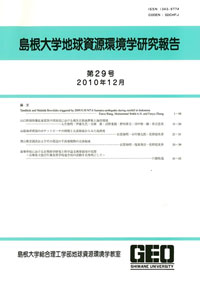島根大学総合理工学部地球資源環境学教室
ISSN:1343-9774

ダウンロード数 : ? 件
この文献の参照には次のURLをご利用ください : https://ir.lib.shimane-u.ac.jp/3265
島根大学地球資源環境学研究報告 19
2000-12-25 発行
Geological Structures and Tectonics around the Koka Reservoir, Northern Main Ethiopian Rift
横田 修一郎
Fantaye Sileshi Mamo
ファイル
内容記述(抄録等)
The Koka dam and its reservoir,located in the northern Main Ethiopian Rift,are the main facilities for irrigation and hydroelectric power in Ethiopia.However,a considerable water leakage from the reservoir has observed since the completion of the Koka dam in 1960.Topographical and geological conditions around the reservoir have been studied to obtain fundamental infomation on paths of leakage.The reservoir area is located in the Wonji Fault Belt of the northern Main Ethiopian Rift,and is characterized by small horst and graben structuers with distinct fault scarplets.The structures are elongated NNE-SSW in the northeastern hills of the reservoir,which is the probable leakage zone,and they obliquely intersect the course of the Awash River flowing out from the reservoir.The northeastern hills consist of rhyolitic ignimbrites and various volcanic rocks intercalated with post-Pliocene pumiceous and lacustrine deposits.They dip gently,but are partially displaced by faults.
Considering that uplift and tilting of fault blocks continued during the Quaternary,such movements may have shifted the course of the river.A low elevation zone elongated northeastward from a point 3.5 km south of the Koka dam was inferred to be an old river course.Although this zone is partially divided by an uplifted horst mound,it is elongated northeastward from the reservoir bank.In contrast,the current river course where the Koka dam was constructed is deep,and maybe a newer one.While the former is characterized by remarkably weathered rock mass,the latter is fresh due to rapid dissection.Based on these topographical and geological characteristics,the low elevation zone corresponding to a paleo-channel might have become a leakage path as water level rose after inundation.
Considering that uplift and tilting of fault blocks continued during the Quaternary,such movements may have shifted the course of the river.A low elevation zone elongated northeastward from a point 3.5 km south of the Koka dam was inferred to be an old river course.Although this zone is partially divided by an uplifted horst mound,it is elongated northeastward from the reservoir bank.In contrast,the current river course where the Koka dam was constructed is deep,and maybe a newer one.While the former is characterized by remarkably weathered rock mass,the latter is fresh due to rapid dissection.Based on these topographical and geological characteristics,the low elevation zone corresponding to a paleo-channel might have become a leakage path as water level rose after inundation.
Other Article
PP. 101 - 112
PP. 113 - 125
